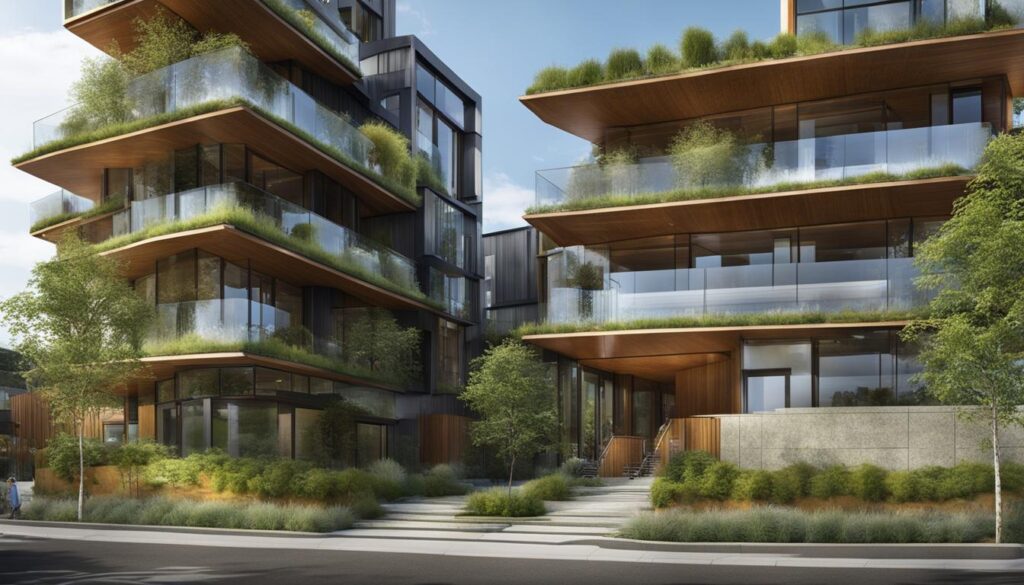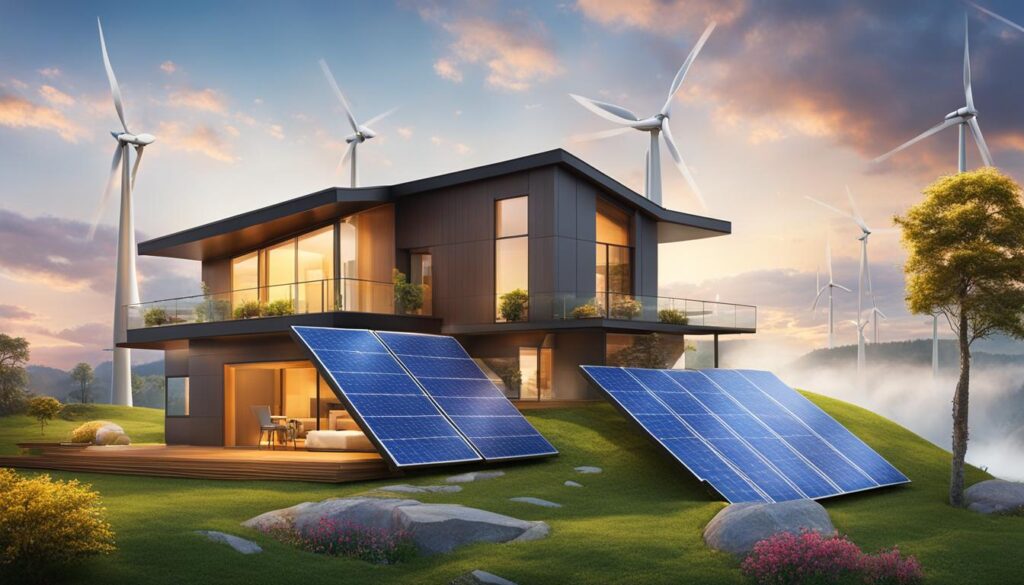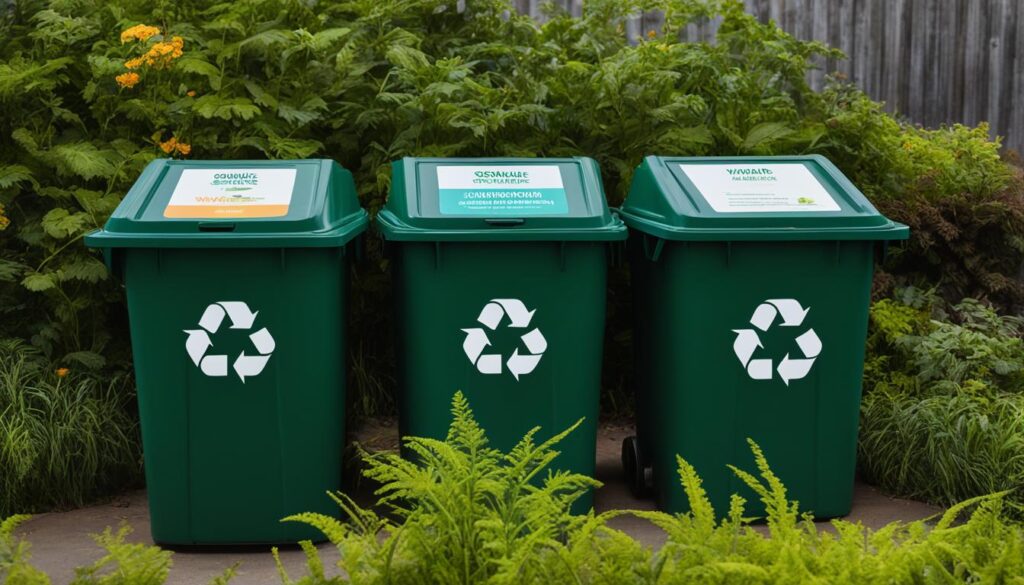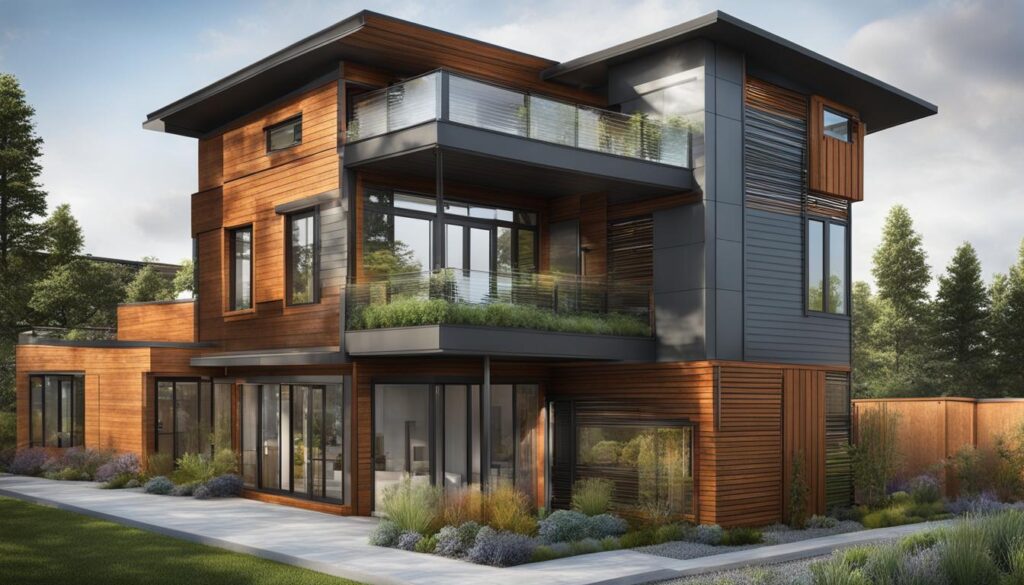As architects and builders, we have a responsibility to consider the impact our buildings have on the environment. Incorporating sustainable design and construction practices not only reduces our carbon footprint but also creates long-lasting and energy-efficient structures.
In this article, we will explore the key components of a sustainable building in Victoria, including the use of eco-friendly materials, energy-efficient design strategies, water conservation practices, renewable energy systems, and waste management solutions. Additionally, we will discuss the benefits of these practices and how they can contribute to a more sustainable future.
Key Takeaways
- Using sustainable building practices can reduce our carbon footprint and create energy-efficient structures.
- The key components of sustainable building include eco-friendly materials, energy-efficient design strategies, water conservation practices, renewable energy systems, waste management solutions, and sustainable landscaping.
- Sustainable buildings promote a more sustainable future and can result in cost savings over time.
- Building sustainably requires a holistic approach and consideration of the structure’s entire lifecycle.
- Sustainable buildings can enhance the health and well-being of occupants and contribute to a more resilient community.
Sustainable Building Materials
When it comes to building a sustainable structure, materials play a crucial role in reducing environmental impact and promoting longevity. By using environmentally friendly, locally-sourced materials, we can create long-lasting, energy-efficient buildings that benefit both the environment and the economy.
One of the key sustainable building materials is locally sourced timber, which has a low embodied energy and can be produced in a sustainable manner. Another option is recycled steel, which significantly reduces carbon emissions and diverts waste from landfills.
Low VOC (volatile organic compound) products are another important component of sustainable building materials. These products contain fewer harmful chemicals, resulting in better indoor air quality and reducing environmental harm. They are particularly beneficial for individuals with respiratory issues or allergies.
When choosing sustainable building materials, it is essential to consider the environmental impact throughout the entire lifecycle of the material, from production to disposal. By prioritizing eco-friendly options, we can create buildings that are both functional and environmentally responsible.
Comparison of Sustainable Building Materials
| Material | Benefits |
|---|---|
| Locally sourced timber | Low embodied energy, sustainable production methods |
| Recycled steel | Significantly reduces carbon emissions, reduces landfill waste |
| Low VOC products | Better indoor air quality, fewer harmful chemicals |
Overall, incorporating sustainable building materials is a crucial aspect of creating sustainable buildings. By taking a mindful approach to materials selection, we can build structures that promote environmental stewardship and benefit our communities.
Energy-Efficient Design
Designing a building with energy-efficient features is crucial in creating a sustainable structure. By implementing strategies like passive solar design, proper insulation, and the use of energy-efficient appliances and lighting, we can greatly reduce the energy consumption of a building. Passive solar design takes advantage of natural light and heat gain, using a building’s orientation, windows, and shading to optimize its heating and cooling. Proper insulation helps maintain a comfortable indoor environment while reducing energy waste. Energy-efficient appliances and lighting, such as LED lights and Energy Star-rated appliances, consume less electricity, reducing the overall demand for energy.
Passive Solar Design

“Passive solar design is an essential element of sustainable building, as it minimizes the need for mechanical heating or cooling, leading to long-term energy savings.”
Passive solar design harnesses the power of natural sunlight and heat to heat and cool a building, reducing the need for central heating and air conditioning. Design features include properly oriented windows, thermal mass, and shading devices on the building facade. When done correctly, passive solar design can significantly reduce a building’s energy consumption while enhancing occupant comfort levels.
Proper Insulation
“Proper insulation is necessary to maintain a comfortable indoor environment and reduce energy waste, making it a vital component of a sustainable building.”
Proper insulation is key to ensuring energy efficiency by reducing heat transfer between interior and exterior spaces. Insulation materials such as cellulose or recycled fiberglass can be used in walls, ceilings, and floors, minimizing air conditioning and heating requirements. An effectively insulated building also promotes a more comfortable indoor space while limiting heat loss in the winter and heat gain in the summer.
Energy-Efficient Appliances and Lighting
“Energy-efficient appliances and lighting greatly contribute to the overall energy savings of a building.”
The use of energy-efficient appliances and lighting decreases a building’s energy demand, thereby reducing energy costs and greenhouse gas emissions. Appliances with an Energy Star rating consume less electricity, offer reduced standby power, and are built for long-term reliability. LED lighting uses up to 90% less energy than traditional lighting, aiding in energy conservation efforts.
Water Conservation Practices
In sustainable building, implementing water conservation practices is crucial for reducing water usage and promoting efficient water management. By using low-flow fixtures, rainwater harvesting systems, and greywater recycling, we can minimize water waste and help conserve our freshwater resources.
Low-flow fixtures like faucets, showerheads, and toilets, consume less water than traditional fixtures, resulting in lower water bills and reducing strain on local water supplies. Rainwater harvesting systems involve collecting rainwater from roof surfaces and storing it for later use in irrigation or toilet flushing. Greywater recycling involves treating and reusing household wastewater for non-potable purposes like irrigating gardens and flushing toilets.
Implementing these water conservation practices not only helps conserve our water resources but can also reduce pressure on our sewage systems, lower energy consumption, and decrease water treatment costs.
The Benefits of Water Conservation Practices
Implementing water conservation practices can lead to several benefits, including:
- Reduced water bills
- Conservation of freshwater resources
- Decreased strain on local water supplies
- Lower energy consumption
- Decreased pressure on sewage systems
- Lower water treatment costs
“Water conservation is key to ensuring a sustainable future for our planet. By implementing these practices in our buildings, we can help conserve our precious resources and promote a healthier environment for all.”
Renewable Energy Systems
As part of our commitment to sustainable building practices in Victoria, we recognize the importance of integrating renewable energy systems into our structures. Renewable energy systems, such as solar panels and wind turbines, can effectively generate clean and sustainable energy for the building.
By utilizing renewable energy systems, we are reducing our dependence on fossil fuels and making strides towards lowering carbon emissions. According to a study by the International Energy Agency, renewable energy sources like solar and wind power are set to become the dominant source of electricity generation by 2030 due to their declining costs and increasing efficiency.

By investing in renewable energy systems, we are not only promoting environmental sustainability but also reducing long-term costs associated with traditional energy sources. Renewable energy systems are becoming increasingly accessible and cost-effective in Victoria, making them a viable option for sustainable building practices.
Passive Solar Design
When it comes to sustainable building design, implementing a passive solar design strategy is a crucial component. Passive solar design uses the building’s orientation, windows, and shading to optimise natural light and heat gain, thus reducing energy consumption and increasing occupant comfort.
The benefits of passive solar design are numerous. By maximising daylight penetration, occupants can reduce their reliance on artificial lighting during the day, leading to significant energy savings in the long run. Moreover, passive solar design can help reduce the need for mechanical heating and cooling, resulting in lower energy bills and a lower carbon footprint for the building.
Passive solar design plays a critical role in creating a comfortable indoor environment. By allowing natural light and warmth into the space, passive solar design contributes to improved mental health and productivity. The optimisation of natural light also reduces glare and eyestrain, creating a healthier and more pleasant workspace.
In addition, passive solar design can enhance the aesthetic appeal of a building. By allowing for natural light, there is an improved visual connection with the surrounding environment, promoting a feeling of unity and harmony with nature.
Waste Management Strategies
At the heart of every sustainable building plan is effective waste management. By incorporating waste management strategies, we can create a circular economy, reducing the amount of waste that ends up in landfills and minimizing our impact on the environment.
One of the most crucial waste management strategies is recycling. By separating recyclable materials like paper, plastic, and glass from other waste, we can reduce the amount of waste sent to landfills and conserve valuable resources.

Another effective strategy for managing waste in sustainable buildings is composting. By converting organic waste into nutrient-rich soil, composting reduces the amount of waste that ends up in landfills while also benefiting plants and gardens.
Comparison Table: Recycling vs. Composting
| Recycling | Composting |
|---|---|
| Reduces waste sent to landfills | Reduces organic waste sent to landfills |
| Conserves resources like paper, plastic, and glass | Provides nutrient-rich soil for plants and gardens |
| Requires separation of recyclable materials | Requires separation of organic waste |
In addition to recycling and composting, waste reduction techniques can also be used to minimize waste generation. These techniques include using digital platforms instead of paper, opting for reusable products like water bottles and shopping bags, and avoiding single-use items like straws and cutlery.
By implementing effective waste management strategies, sustainable buildings benefit both the environment and their occupants. Through conscious waste management, we can reduce our carbon footprint, conserve valuable resources, and promote a circular economy.
Green Roofs
Green roofs are an innovative way to tackle a multitude of environmental issues while simultaneously improving a building’s aesthetic appeal. They are essentially rooftop gardens, where vegetation is planted in specially engineered growing mediums to create an insulative green layer.
The benefits of green roofs are numerous. Firstly, they provide thermal insulation, reducing the amount of heat absorbed by the building and lowering cooling costs during summer months. By evapotranspiration, they also help reduce the “heat island” effect experienced in cities, where temperatures soar due to heat-reflecting surfaces. Secondly, green roofing provides excellent stormwater management by storing water and irrigating plants, consequently reducing the risk of drainage issues and water pollution. Green roofs are also notable for supporting biodiversity, encouraging the proliferation of birds and pollinating insects in urban areas.
There are two forms of green roofing – intensive, which is akin to a rooftop garden and requires significant maintenance, and extensive, which involves low-maintenance ground cover plants and require little upkeep. Additionally, green roofs can be retrofitted on existing buildings or integrated into new building designs.
Green Roofs vs. Traditional Roofing
| Green Roofs | Traditional Roofs | |
|---|---|---|
| Thermal Insulation | Provide excellent thermal insulation | Provide limited thermal insulation |
| Impact on Urban Heat Island | Reduce Urban Heat Island Effect | Aggravates Urban Heat Island Effect |
| Stormwater Management | Provide effective stormwater management capabilities | Contribute to stormwater wastage and pollution |
| Biodiversity Support | Support biodiversity and increase local greenery | Provide no biodiversity support |
The comparison chart above showcases the advantages of green roofing over traditional forms of roofing in terms of thermal insulation, impact on Urban Heat Island, stormwater management, and biodiversity promotion.
Eco-Friendly Insulation
When thinking about building an energy-efficient structure, one cannot overlook proper insulation. It is not only responsible for maintaining a comfortable indoor environment but also plays a significant role in reducing energy bills. Conventional insulation materials can often harm the environment in the long run, causing health issues, and increasing energy consumption.
However, eco-friendly insulation materials like cellulose or recycled fiberglass can effectively solve this problem. Not only are they environmentally sustainable, but they also help trap the heat inside the building, significantly reducing the dependence on HVAC systems.
Using eco-friendly insulation is an affordable way to reduce the carbon footprint of a building while providing long-lasting thermal protection. It is a wise investment in creating an energy-efficient and environmentally sustainable building that will benefit its occupants and the surrounding environment for many years to come.
Rainwater Harvesting
As part of our commitment to sustainable building practices in Victoria, we highly endorse the practice of rainwater harvesting. By collecting and storing rainwater, we can reduce our dependence on municipal water supplies and preserve precious freshwater resources. Rainwater can be repurposed for various non-potable applications, including irrigation and toilet flushing, effectively reducing the strain on our natural water systems.
One effective method of rainwater harvesting is installing a system of gutters and downspouts to collect and channel rainwater into a storage tank. An appropriately sized tank can store enough rainwater to meet the water needs of an average household for months. To ensure the water is suitable for use, it is important to use appropriate filters to remove any debris and contaminants from the collected water.
Aside from the environmental benefits, rainwater harvesting can also result in significant cost savings on water bills and promote self-sufficiency. It can also encourage a deeper appreciation of our natural resources and inspire a conscious effort to reduce wasteful water usage.
By incorporating rainwater harvesting systems into our sustainable building designs, we can create more resilient and environmentally responsible structures. Together, we can work towards a more sustainable future through mindful and conscientious building practices.
Conclusion
Throughout this article, we have explored the key components of sustainable building in Victoria. Incorporating sustainable building materials such as locally sourced timber, recycled steel, and low VOC products can reduce the environmental impact and increase a building’s lifespan. Energy-efficient design strategies such as passive solar design, proper insulation, and energy-efficient appliances can help to reduce energy consumption. Utilizing water conservation practices such as low-flow fixtures, rainwater harvesting systems, and greywater recycling can help to efficiently manage water usage.
Integrating renewable energy systems such as solar panels and wind turbines can reduce dependence on fossil fuels and lower carbon emissions. Passive solar design utilizing a building’s orientation, windows, and shading can enhance energy efficiency and occupant comfort. Waste management strategies such as recycling programs, composting, and waste reduction techniques can help minimize waste generation and promote a circular economy.
Green roofs can offer thermal insulation, stormwater management, and enhance biodiversity. Eco-friendly insulation materials such as cellulose or recycled fiberglass can reduce environmental impact and improve energy efficiency. Harvesting rainwater can conserve freshwater resources and reduce strain on municipal water supplies.
It is important to remember that all of these components work together in creating a truly sustainable building. Furthermore, sustainable landscaping is crucial in creating environmentally friendly and aesthetically pleasing surroundings. Incorporating elements such as native plant species, rain gardens, and permeable paving can promote biodiversity and reduce the environmental impact of landscaping.
By considering and implementing these key sustainable building components, we can contribute to creating a sustainable future for Victoria and beyond.
FAQ
What are the key components of a sustainable building in Victoria?
The key components of a sustainable building in Victoria include sustainable building materials, energy-efficient design, water conservation practices, renewable energy systems, passive solar design, waste management strategies, green roofs, eco-friendly insulation, rainwater harvesting, and sustainable landscaping.
What are sustainable building materials?
Sustainable building materials are environmentally friendly materials that are locally sourced, recycled, and have low VOC (volatile organic compound) content. These materials help reduce the carbon footprint of the building and have a longer lifespan.
How does energy-efficient design contribute to a sustainable building?
Energy-efficient design minimizes energy consumption by utilizing strategies such as passive solar design, proper insulation, and the use of energy-efficient appliances and lighting. This helps reduce the building’s carbon emissions and operational costs.
What are water conservation practices in sustainable building?
Water conservation practices in sustainable building include the use of low-flow fixtures, rainwater harvesting systems, and greywater recycling. These practices help minimize water usage and promote efficient water management.
How do renewable energy systems contribute to sustainable buildings?
Renewable energy systems, such as solar panels and wind turbines, generate clean and sustainable energy for the building. This reduces dependence on fossil fuels, lowers carbon emissions, and promotes a greener energy source.
What is passive solar design?
Passive solar design utilizes a building’s orientation, windows, and shading to optimize natural light and heat gain. This reduces the need for artificial lighting and heating, leading to energy savings and improved occupant comfort.
What are waste management strategies in sustainable buildings?
Waste management strategies in sustainable buildings include recycling programs, composting, and waste reduction techniques. These strategies promote a circular economy, minimize waste generation, and reduce the environmental impact of the building.
What are the benefits of green roofs in sustainable buildings?
Green roofs provide thermal insulation, manage stormwater, and enhance biodiversity. They contribute to energy efficiency, reduce urban heat island effect, and create visually appealing and sustainable rooftop spaces.
What is eco-friendly insulation?
Eco-friendly insulation refers to insulation materials that have a low environmental impact, such as cellulose or recycled fiberglass. These materials enhance energy efficiency, reduce heat loss, and contribute to a comfortable indoor environment.
What is rainwater harvesting?
Rainwater harvesting involves collecting and storing rainwater for various purposes, such as irrigation and toilet flushing. It helps conserve freshwater resources, reduce strain on municipal water supply, and promote sustainable water management.
How does sustainable landscaping contribute to a sustainable building?
Sustainable landscaping involves using water-efficient plants, incorporating native species, and implementing water management techniques. It enhances the building’s surrounding environment, promotes biodiversity, and reduces water consumption.
